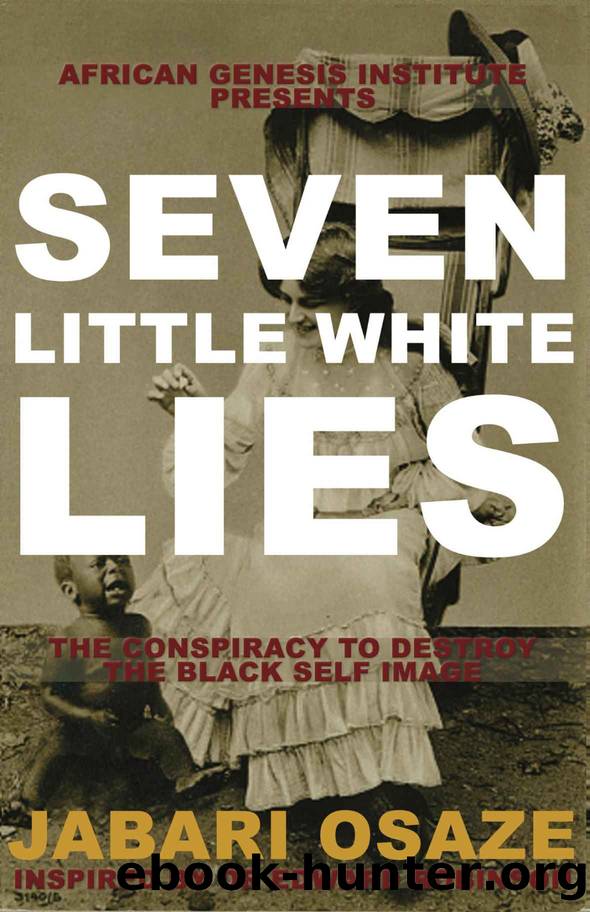7 Little White Lies: The Conspiracy to Destroy the Black Self-Image by Jabari Osaze

Author:Jabari Osaze [Osaze, Jabari]
Language: eng
Format: azw3, epub
Publisher: African Genesis Institute Press
Published: 2016-04-11T16:00:00+00:00
Image 5.2: Statue of Frederick Douglass in Harlem, NY - Formerly enslaved African, author, and powerful rhetorician, Frederick Douglass had a long partnership with the most popular abolitionist of European descent, William Lloyd Garrison. Douglass and Garrison were often known to share the stage at public events. In these engagements Douglass would recount the horrors of his personal experiences with enslavement while Garrison and other members of the American AntiSlavery Society would provide the philosophy behind abolitionism. This relationship began to unravel when Douglass decided to play a larger role. He wanted to also provide his own analysis, as any fierce, sharp-minded intellectual would do. Douglass in a primary role seems to have been difficult for Garrison and other abolitionist of European descent.3
People of European descent who had a vested interest in the system of slavery continued to describe Africans as fortunate to be forcibly removed from their savage homeland. Many of the comments about African lives on plantations were quite similar to those delivered to the British Parliament on the middle passage.
... we ought to consider whether the negroes in a well regulated plantation, under the protection of a kind Master, do not enjoy as great, nay even greater advantages than when under their own despotic governments, or even than the greater part of our common labourers, our tradesmen, and our manufacturers; but even in these examples, it will be said, they have a free agency, a liberty of their own, nor can I deny it, though I may with confidence say that this liberty is rather a detriment, than an advantage to them; it is their common practice on the Saturday Night, when they receive their wages, to sit down to drinking, and not to return, in general, to their work, until nearly half of the week is expired, from which period they are obliged to labour harder than any slave, under even the most cruel Master ...4
Wealthy English politician and 1st Earl of Sheffield5, John Baker Holroyd argued that immediate termination of the Trans-Atlantic trade of enslaved Africans might create an economic hardship. He was a proponent of "slave breeding", as it could eventually make the kidnapping of Africans obsolete. With an acknowledgement of the brutality of the journey by "slave ship", Holroyd's view might have been considered more humane. Clearly this view was not based on recognition of the humanity of Africans.
Holroyd not only argues that the Africans were better off under western enslavement than they were in their African homeland, but he adds another oft-mentioned aspect to the argument. Africans were already enslaved by their countrymen in Africa. Western enslavement is more humane.
Although we have no right to determine or choose for the Negroes, in respect to their removal from Africa to the West Indies, yet there seems little doubt that their situation is in general changed much for the better. They are slaves in Africa and their lives as much at the mercy of their uncivilised owners as those of their cattle. They are slaves still, but to civilised masters.
Download
7 Little White Lies: The Conspiracy to Destroy the Black Self-Image by Jabari Osaze.epub
This site does not store any files on its server. We only index and link to content provided by other sites. Please contact the content providers to delete copyright contents if any and email us, we'll remove relevant links or contents immediately.
| Africa | Americas |
| Arctic & Antarctica | Asia |
| Australia & Oceania | Europe |
| Middle East | Russia |
| United States | World |
| Ancient Civilizations | Military |
| Historical Study & Educational Resources |
Stolen by Richard Bell(752)
Medical Apartheid: The Dark History of Medical Experimentation on Black Americans From Colonial Times to the Present by Harriet A. Washington(670)
My Vanishing Country by Bakari Sellers(666)
We Could Not Fail by Richard Paul(664)
The Broken Heart of America by Walter Johnson(660)
Bending Toward Justice : The Birmingham Church Bombing That Changed the Course of Civil Rights (9781250201454) by Jones Doug(625)
The New Negro by Jeffrey C. Stewart(606)
Overground Railroad by Candacy Taylor(591)
Black Slaves, Indian Masters by Barbara Krauthamer(580)
The End of White World Supremacy by Malcolm X(561)
Jackson, 1964: And Other Dispatches From Fifty Years of Reporting on Race in America by Calvin Trillin(544)
The Last Hero: A Life of Henry Aaron by Howard Bryant(515)
The Black Panthers by Bryan Shih(510)
The Broken Heart of America: St. Louis and the Violent History of the United States by Walter Johnson(507)
The Price for Their Pound of Flesh by Daina Ramey Berry(501)
African American History For Dummies by Ronda Racha Penrice(493)
The Birth of a Movement by Dick Lehr(492)
Hattiesburg by William Sturkey(461)
A Dreadful Deceit by Jacqueline Jones(454)
